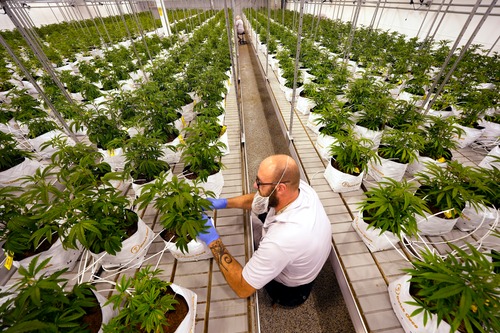Sleep is one of the most vital pillars of health, yet it remains one of the most fragile. Many people struggle with falling asleep, staying asleep, or maintaining a consistent sleep schedule. Cannabis, particularly its cannabinoids like THC and CBD, has become a popular tool for managing sleep difficulties. But a deeper question arises: does the timing of cannabis use, in alignment with the body’s circadian rhythms, make it more effective for improving sleep?
Understanding Circadian Rhythms
Circadian rhythms are the body’s internal 24-hour clock that regulates biological processes such as hormone release, metabolism, and sleep-wake cycles. Controlled by the brain’s suprachiasmatic nucleus (SCN), these rhythms synchronize with external cues like light and darkness. When circadian rhythms are balanced, people tend to fall asleep and wake up naturally. Disruptions—such as late-night screen use, shift work, or jet lag—can cause insomnia, poor sleep quality, and fatigue.
How Cannabis Interacts with Sleep
Cannabis influences the endocannabinoid system (ECS), which helps regulate mood, pain, and sleep cycles. THC has sedative properties, often reducing the time it takes to fall asleep. CBD, on the other hand, may promote relaxation and help manage anxiety, indirectly supporting better sleep quality. Together, cannabinoids interact with receptors in the brain that play a role in sleep regulation, such as CB1 receptors in the central nervous system.
Timing Cannabis with Circadian Rhythms
The time of cannabis consumption can significantly affect how it influences sleep. Using THC too early in the day may disrupt productivity, while taking it too late might impact the quality of rest. Aligning cannabis use with circadian rhythms means consuming it during the body’s natural “winding down” period—usually in the evening. This is when melatonin levels rise, signaling to the body that it is time to prepare for sleep.
Evening Use and Sleep Initiation
For people struggling with insomnia, consuming cannabis 1–2 hours before bedtime may help ease the transition to sleep. Strains or products higher in THC are often reported to shorten sleep latency (the time it takes to fall asleep). For individuals who experience racing thoughts or stress at night, cannabis can provide a calming effect, synchronizing well with the body’s natural shift into rest mode.
Midday Use and Napping
Some people use cannabis earlier in the day to encourage relaxation or even short naps. However, this can interfere with circadian rhythms if done frequently, as it may reduce sleep drive at night. Over time, irregular consumption patterns may contribute to a disrupted sleep-wake cycle, undermining the body’s ability to maintain consistent circadian timing.
Morning Use and Wakefulness
Interestingly, low doses of CBD or certain sativa-dominant strains taken in the morning may support wakefulness rather than sedation. By reducing anxiety or improving mood, cannabis might indirectly promote healthier circadian alignment, especially in individuals whose poor mental health impacts their sleep cycle.
The Role of Strain Selection
Different cannabis strains play different roles in circadian alignment:
- Indica-dominant strains: Often recommended for evening use due to their sedative effects.
- Sativa-dominant strains: Typically more energizing and may be better suited for morning or daytime use.
- Hybrids: Can provide a balanced experience, depending on cannabinoid and terpene profiles.
Terpenes such as myrcene and linalool may enhance sleep-inducing effects, while limonene and pinene are more uplifting. Choosing the right strain for the right time of day is essential for aligning cannabis use with circadian rhythms.
Risks of Poor Timing
While cannabis may help regulate sleep, mistimed consumption can disrupt circadian rhythms. For example:
- Using high-THC products too close to bedtime may reduce REM sleep, which is vital for memory consolidation and emotional processing.
- Daytime overuse can lead to grogginess, daytime naps, and nighttime restlessness.
- Inconsistent timing—using cannabis at different hours each day—can confuse the body’s circadian clock, leading to irregular sleep-wake cycles.
Practical Tips for Timing Cannabis Use
- Establish a routine: Consume cannabis at the same time each night to reinforce your circadian rhythm.
- Choose the right product: Opt for indica strains or THC-rich edibles in the evening, and consider CBD-dominant products if anxiety is the primary barrier to sleep.
- Start low, go slow: Use small doses to minimize risks of dependence or next-day grogginess.
- Pair with sleep hygiene: Dim lights, avoid screens, and create a relaxing environment to maximize cannabis’s sleep-promoting effects.
Conclusion
Cannabis can be a valuable tool for improving sleep, but its effectiveness depends heavily on timing. Aligning cannabis use with circadian rhythms may enhance natural sleep processes, helping individuals fall asleep faster, sleep more deeply, and wake up feeling more refreshed. However, poor timing or overuse can disrupt these rhythms and compromise recovery. By combining mindful cannabis consumption with healthy sleep practices, individuals can harness both the power of the plant and the wisdom of the body’s internal clock.


